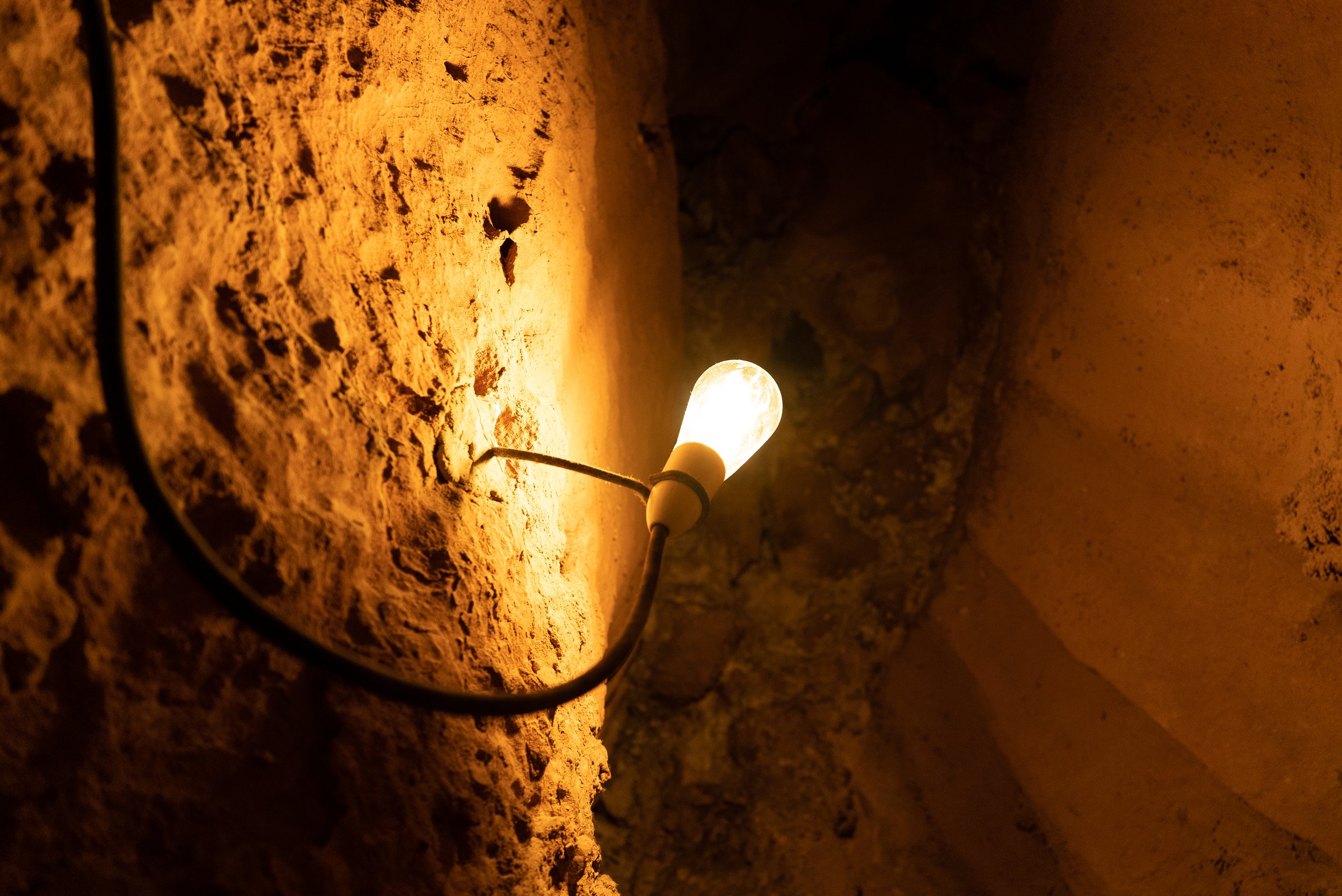
Flashing its Brilliant Rays!
Candlelight
Candles, which the first cave explorers easily carried, have distinct disadvantages. A strong breeze can blow out the flame. Wax can drip on clothes and crystal features. Worst of all a candle and matches could be dropped into a pool of water.
The earliest visitors would stoop and sometimes crawl through narrow gaps, clutching their precious candle. One said, “Great care should be taken about candles as owing to the lack of space it would be very easy to set oneself on fire and very difficult after to extinguish” (J.J. Foster 1890)
Magnesium Lamps
An improvement was the magnesium wire lamp, which used a clockwork mechanism to wind the burning wire off a drum into a large reflector dish. Then, cave features could be individually illuminated to everyone’s satisfaction.
In 1887, an innovation that was remarked on was the ‘electric searchlight of 120 candle power’. "Carried through the Imperial Cave, it can be connected to all the important points, brings out every detail of the marvelous formations and fully puts the magnesium lamp in the shade." (SMH 17/2/1887)
First Electric cave light
In November 1879, Thomas Edison patented his new invention, the vacuum light bulb with carbon filament. Less than a year later, in July 1880, on the other side of the world, Lieutenant Colonel E.C. Cracknell, Superintendent of Telegraphs, conducted an electric lighting experiment in the Left Imperial Cave.
A cave environment would provide the perfect setting to show what electric light could do. The chamber chosen was at the top of the present day stairs to the Chifley Cave as it was the most richly decorated.
You can still see an indication of the kind of lighting that Cracknell and Hart produced in that first chamber (called the Margarita Cave after Cracknell’s wife). The solitary bulb still used today, with a carbon element, dates from around 1920. This light would be augmented by a magnesium lamp. As the power supply improved, a hand-held electric lamp could be trained onto a cave feature.
Steam Power Generator
Power for the electrical lighting installations was initially provided by a wood fired steam generator in the Grand Arch.
Due to its limited generating capacity, banks of 10 lights could be turned on at any one time, and they were liable to dim, due to the fluctuations in power supply.
Still, it was a wonderful innovation! It would be another 20 years before Sydney had street lights, and most domestic dwellings remained lit by gas for many years to come. Even Bathurst Hospital, for example, did not gain electric light until 1924.
The Leffel Wheel - Australia's first hydro power
In 1888, a water-driven turbine was ordered from James Leffel and Co. in the USA. Commonly called the Leffel Wheel, this was the first example of hydro-electric power being used to generate electricity in Australia.
The Imperial River was dammed, where it flowed into a swampy area beyond the Grand Arch. Wrought iron pipes, 650 mm in diameter, took the water down 200 metres in a gradual descent, to the site of the Leffel Wheel.
Hydro Electric Power Station
Although adequate for the existing caves, the discovery of the River Cave, the Temple of Baal Cave, Orient Cave and Pool of Cerberus Cave meant that further power was needed. The 1908 solution was to build another dam, considerably larger than the 1889 one. The turbine and its 2 generators were moved further down the valley, to create a greater head of water. The Jenolan Lake, now more commonly called the Blue Lake, was created.
With the expansion of Caves House to three stories in the middle of the First World War, the Leffel Wheel was decommissioned. The decommissioning was delayed because the ship carrying the new equipment from Britain was torpedoed by a German submarine.
A new hydro-electric power station was built, with 2 turbines and 2 generators, in their own power house, 900 metres downstream from the Grand Arch. The 20 kW generators were from the Westinghouse Company. The 2 Pelton wheel turbines were from James Gordon & Company. They were all turned on in 1916.
Lighting in the 21st Century
During the new century, with new technology, it was decided to relight the entire cave system. The Imperial Cave was the first to have the C–Bus system. This is a microprocessor based control and management operating system, triggered by remote control.
The great advantage of this system is that it operates at a much reduced voltage thus drawing much less power. The new lights give off very little heat.
The Carbon footprint of Jenolan Caves, once the size of an elephant, is now the size of a small bird.


